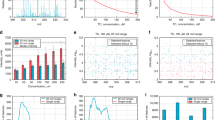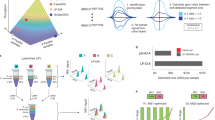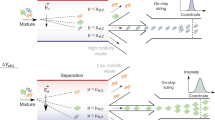Abstract
Frontal affinity chromatography (FAC) is a biophysical method for the discovery and characterization of molecular interactions in a flow-based system. Several different modes of analysis are possible by interfacing to the mass spectrometer, including robust single-compound characterizations as well as high-throughput screening of over 1,000 compounds per run. The method supports thermodynamic and kinetic characterization of interactions for a wide range of molecular species and possesses similarities to flow-based biosensors such as surface plasmon resonance. It offers sensitive detection of ligands present well below their respective dissociation constants, and can be assembled from readily available laboratory components. Direct coupling of the FAC cartridge to the mass spectrometer is useful for the interrogation of single compounds or mixtures of limited complexity. An offline fractionation schema is more appropriate for discovery-mode applications. A high-performance FAC system enabling both modes can be assembled in 2–3 h. Measurements of dissociation constants can be made with such a system in 0.5–3 h, and the system supports higher-throughput screening modes at a rate of 10,000 compounds d−1.
This is a preview of subscription content, access via your institution
Access options
Subscribe to this journal
Receive 12 print issues and online access
$259.00 per year
only $21.58 per issue
Buy this article
- Purchase on Springer Link
- Instant access to full article PDF
Prices may be subject to local taxes which are calculated during checkout







Similar content being viewed by others
References
Guiochon, G., Shirazi, S.G. & Katti, A.M. Fundamentals of Preparative and Nonlinear Chromatography (Academic Press, Toronto, 1994).
Schriemer, D.C. Biosensor alternative: frontal affinity chromatography. Anal. Chem. 76, 440A–448A (2004).
Kasai, K. & Ishii, S. Quantitative analysis of affinity chromatography of trypsin. A new technique for investigation of protein-ligand interaction. J. Biochem. 77, 261–264 (1975).
Hirabayashi, J. et al. Oligosaccharide specificity of galectins: a search by frontal affinity chromatography. Biochim. Biophys. Acta 1572, 232–254 (2002).
Hirabayashi, J., Arata, Y. & Kasai, K. Glycome project: concept, strategy and preliminary application to Caenorhabditis elegans. Proteomics 1, 295–303 (2001).
Schriemer, D.C., Bundle, D.R., Li, L. & Hindsgaul, O. Micro-scale frontal affinity chromatography with mass spectrometric detection: a new method for the screening of compound libraries. Ang. Chem.-Int. Ed. 37, 3383–3387 (1998).
Kasai, K. & Oda, Y.J. Frontal affinity chromatography: theory for its application to studies on specific interaction of biomolecules. J. Chromatogr. 376, 33–47 (1986).
Chan, N.W., Lewis, D.F., Rosner, P.J., Kelly, M.A. & Schriemer, D.C. Frontal affinity chromatography-mass spectrometry assay technology for multiple stages of drug discovery: applications of a chromatographic biosensor. Anal. Biochem. 319, 1–12 (2003).
Boozer, C., Kim, G., Cong, S., Guan, H. & Londergan, T. Looking towards label-free biomolecular interaction analysis in a high-throughput format: a review of new surface plasmon resonance technologies. Curr. Opin. Biotechnol. 17, 400–405 (2006).
Duverger, E., Frison, N., Roche, A.C. & Monsigny, M. Carbohydrate-lectin interactions assessed by surface plasmon resonance. Biochimie 85, 167–179 (2003).
Myszka, D.G. Improving biosensor analysis. J. Mol. Recogn. 12, 279–284 (1999).
Lundqvist, A. & Lundahl, P. Chromatography on cells and biomolecular assemblies. J. Chromatogr. B Biomed. Sci. Appl. 699, 209–220 (1997).
Moaddel, R., Cloix, J.-F., Ertem, G. & Wainer, I.W. Multiple receptor liquid chromatographic stationary phases: the co-immobilization of nicotinic receptors, γ-amino-butyric acid receptors, and N-methyl-d-aspartate receptors. Pharm. Res. 19, 104–107 (2002).
Grandics, P. Immobilization of proteins (antibodies) to supports with a constantly high retention of immunoreactivity involving the formation of a Schiff-base and subsequent reduction to a secondary amine with sodium borohydride or sodium cyanoborohydride has been problematical. Appl. Biochem. Biotechnol. 15, 163–167 (1987).
Hodgson, R.J. et al. Protein-doped monolithic silica columns for capillary liquid chromatography prepared by the sol-gel method: applications to frontal affinity chromatography. Anal. Chem. 76, 2780–2790 (2004).
Kopetzki, E., Lehnert, K. & Buckel, P. Enzymes in diagnostics: achievements and possibilities of recombinant DNA technology. Clin. Chem. 40, 688–704 (1994).
Gottschalk, I., Li, Y.M. & Lundahl, P. Chromatography on cells: analyses of solute interactions with the glucose transporter Glut1 in human red cells adsorbed on lectin-gel beads. J. Chromatogr. B Biomed. Sci. Appl. 739, 55–62 (2000).
Jozwiak, K., Haginaka, J., Moaddel, R. & Wainer, I.W. Displacement and nonlinear chromatographic techniques in the investigation of interaction of noncompetitive inhibitors with an immobilized alpha3beta4 nicotinic acetylcholine receptor liquid chromatographic stationary phase. Anal. Chem. 74, 4618–4624 (2002).
Moaddel, R. & Wainer, I.W. Immobilized nicotinic receptor stationary phases: going with the flow in high-throughput screening and pharmacological studies. J. Pharm. Biomed. Anal. 30, 1715–1724 (2003).
Moaddel, R., Bullock, P.L. & Wainer, I.W. Development and characterization of an open tubular column containing immobilized P-glycoprotein for rapid on-line screening for P-glycoprotein substrates. J. Chromatogr. B Analyt. Technol. Biomed. Life Sci. 799, 255–263 (2004).
Moaddel, R., Hamid, R., Patel, S., Bullock, P.L. & Wainer, I.W. Identification of P-glycoprotein substrates using open tubular chromatography on an immobilized P-glycoprotein column: comparison of chromatographic results with Caco-2 permeability. Anal. Chim. Acta 578, 25–30 (2006).
Chan, N.W., Lewis, D.F., Hewko, S., Hindsgaul, O. & Schriemer, D.C. Frontal affinity chromatography for the screening of mixtures. Comb. Chem. High Throughput Screen 5, 395–406 (2002).
Ng, E.S. et al. High-throughput screening for enzyme inhibitors using frontal affinity chromatography with liquid chromatography and mass spectrometry. Anal. Chem. 77, 6125–6133 (2005).
Kovarik, P., Hodgson, R.J., Covey, T., Brook, M.A. & Brennan, J.D. Capillary-scale frontal affinity chromatography/MALDI tandem mass spectrometry using protein-doped monolithic silica columns. Anal. Chem. 77, 3340–3350 (2005).
Day, Y.S., Baird, C.L., Rich, R.L. & Myszka, D.G. Direct comparison of binding equilibrium, thermodynamic, and rate constants determined by surface- and solution-based biophysical methods. Protein Sci. 11, 1017–1025 (2002).
Wade, J.L., Bergold, A.F. & Carr, P.W. Theoretical description of nonlinear chromatography, with applications to physicochemical measurements in affinity chromatography and implications for preparative-scale separations. Anal. Chem. 59, 1286–1295 (1987).
Jacobson, J.M., Frenz, J.H. & Horvath, C. Measurement of competitive adsorption isotherms by frontal chromatography. Ind. Eng. Chem. Res. 26, 43–50 (1987).
Zhang, B. et al. Frontal affinity chromatography coupled to mass spectrometry for screening mixtures of enzyme inhibitors. Anal. Biochem. 299, 173–182 (2001).
Nilsson, J., Stahl, S., Lundeberg, J., Uhlen, M. & Nygren, P.A. Affinity fusion strategies for detection, purification, and immobilization of recombinant proteins. Protein Expr. Purif. 11, 1–16 (1997).
Nisnevitch, M. & Firer, M.A. The solid phase in affinity chromatography: strategies for antibody attachment. J. Biochem. Biophys. Methods 49, 467–480 (2001).
Rempel, B.P., Winter, H.C., Goldstein, I.J. & Hindsgaul, O. Characterization of the recognition of blood group B trisaccharide derivatives by the lectin from Marasmius oreades using frontal affinity chromatography-mass spectrometry. Glycoconj. J. 19, 175–180 (2002).
Author information
Authors and Affiliations
Corresponding author
Ethics declarations
Competing interests
As one of the original developers of the FAC systems is now employed at Upchurch Scientific, we have continued prototype development work with this company. They do not sell any FAC systems, but as a number of their individual components are used, we are declaring competing financial interests on behalf of this author (Dr. Darren Lewis). There are no competing financial interests for the other authors. Note that we have taken care to specific alternative suppliers of components where possible, to avoid a vendor bias.
Rights and permissions
About this article
Cite this article
Ng, E., Chan, N., Lewis, D. et al. Frontal affinity chromatography—mass spectrometry. Nat Protoc 2, 1907–1917 (2007). https://doi.org/10.1038/nprot.2007.262
Published:
Issue Date:
DOI: https://doi.org/10.1038/nprot.2007.262
This article is cited by
-
New platform for simple and rapid protein-based affinity reactions
Scientific Reports (2017)
-
Development of new chromatographic tools based on A2A adenosine receptor subtype for ligand characterization and screening by FAC-MS
Analytical and Bioanalytical Chemistry (2013)
-
Recent developments in protein–ligand affinity mass spectrometry
Analytical and Bioanalytical Chemistry (2011)
-
Automated solid-phase microextraction and thin-film microextraction for high-throughput analysis of biological fluids and ligand–receptor binding studies
Nature Protocols (2010)
-
The preparation and development of cellular membrane affinity chromatography columns
Nature Protocols (2009)
Comments
By submitting a comment you agree to abide by our Terms and Community Guidelines. If you find something abusive or that does not comply with our terms or guidelines please flag it as inappropriate.



